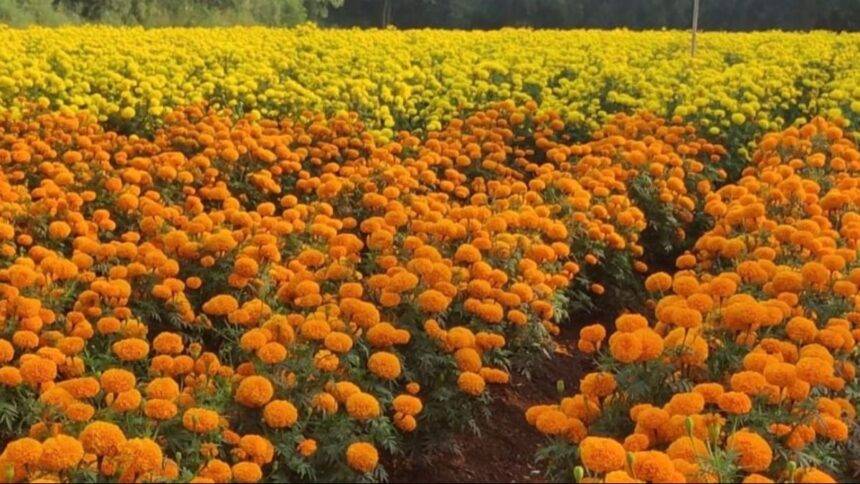Main Points In Hindi (मुख्य बातें – हिंदी में)
-
फूलों की खेती का लाभ: हिमाचल प्रदेश के पैडधर में किसान अब जंगली मैरीगोल्ड की खेती कर रहे हैं, जिसे देने के लिए राज्य सरकार सब्सिडी में 30,000 रुपये प्रति हेक्टेयर की सहायता प्रदान कर रही है, जिससे किसानों की आय में सुधार हो रहा है।
-
तेल निकालने की सुविधा: किसानों को हिमाॅलायन बायोरेसौर्स टेक्नोलॉजी इंस्टीट्यूट द्वारा स्थापित मशीन का लाभ मिला है, जिससे वे जंगली मैरीगोल्ड का तेल निकालने और बेचने में सक्षम हो रहे हैं, जिससे उनकी खर्चे कम हुए हैं।
-
उत्पादन और लाभ: प्रति हेक्टेयर जंगली मैरीगोल्ड की खेती पर लगभग 80,000 रुपये का खर्च आता है, जबकि इसमें से 2,52,000 रुपये की संभावित आमदनी होती है। इससे किसानों को प्रति हेक्टेयर 1,72,000 रुपये का नेट लाभ हो सकता है।
-
उपयोगिताएँ: जंगली मैरीगोल्ड के तेल का उपयोग खाद्य प्रोसेसिंग, कॉस्मेटिक्स और फार्मास्यूटिकल इंडस्ट्री में किया जाता है। इसका तेल विभिन्न खाद्य उत्पादों और दवाओं में सुगंधित घटक के रूप में बहुत मांग में रहता है।
- सफलता की कहानी: किसान दरसन लाल, जिसने 100 बिघा में जंगली मैरीगोल्ड की खेती की है, ने इससे सालाना 2 लाख रुपये कमाने में सफलता हासिल की है।
Main Points In English(मुख्य बातें – अंग्रेज़ी में)
-
Shift to Wild Marigold Cultivation: Farmers in Paddhar, Himachal Pradesh, are transitioning from traditional grain and vegetable farming to cultivating wild marigold, finding it to be a more profitable venture supported by government subsidies for floriculture, amounting to Rs 30,000 per hectare.
-
Financial Benefits and Support: Farmer Darshan Lal successfully leveraged a subsidy of Rs 2.5 lakh from the Horticulture Department to construct a shed for storing wild marigolds, mitigating losses from spoilage and reducing transportation costs by utilizing a local oil extraction machine.
-
High Profit Potential: The cultivation of wild marigold has significant profit margins, with costs around Rs 80,000 per hectare and potential earnings from oil extraction reaching up to Rs 2,52,000 per hectare, translating to a net profit of Rs 1,72,000 after expenses.
-
Diverse Market Demand: Wild marigold oil is in great demand across various industries, including cosmetics, food processing, and pharmaceuticals, due to its appealing fragrance and beneficial properties, making it a valuable product for farmers.
- Government Initiatives: The Himachal Pradesh government is encouraging the promotion of wild marigold farming through initiatives like the Mehak Scheme, supporting farmers in adopting this profitable agricultural practice.
Complete News In Hindi(पूरी खबर – हिंदी में)


आजकल, हिमाचल प्रदेश के पद्धर में किसान एक नए प्रकार की खेती कर रहे हैं। उन्होंने अनाज और सब्जियों की खेती छोड़कर जंगली गेंदा (मारिगोल्ड) की खेती शुरू कर दी है। यह खेती अब उनके लिए फायदे का सौदा बन रही है। इस खेती का बड़ा फायदा यह है कि हिमाचल प्रदेश सरकार फूलों की खेती के लिए किसानों को सब्सिडी दे रही है। इसमें किसानों को प्रति हेक्टेयर 30 हजार रुपये की सब्सिडी मिलती है। इस योजना का लाभ उठाकर पद्धर के किसान दर्शन लाल अच्छे पैसे कमा रहे हैं। वे कहते हैं कि वे और गांव के अन्य लोग मिलकर 100 बीघा में जंगली गेंदा उगा रहे हैं। इस फूल से टेगेटेस तेल निकलता है, जो महंगे दाम पर बिकता है।
इस खेती के लिए दर्शन लाल ने बागवानी विभाग से संपर्क किया और एक शेड बनाने के लिए 2.50 लाख रुपये की सब्सिडी ली। इस शेड में वे जंगली गेंदा रखते हैं ताकि बारिश में फूल खराब न हों। वे बताते हैं कि पहले उन्हें अपने फूलों को तोड़कर नेर चौक मंडी ले जाना पड़ता था, जहां फूलों से तेल निकाला जाता था। इससे खर्च बढ़ जाता था, क्योंकि परिवहन महंगा होता था। बाद में, हिमालयन जैव संसाधन प्रौद्योगिकी संस्थान, पालमपुर ने उनके सिउं पंचायत में एक मशीन लगाई, जहां तेल निकालने का काम शुरू हुआ।
इस मशीन से दर्शन लाल और कई अन्य किसानों को लाभ हुआ, जो यहाँ जाकर जंगली गेंदा 23 रुपये प्रति किलो की दर से बेचते हैं। उसी मशीन पर गेंदा का तेल भी निकाला जाता है, जो बाजार में 12 से 15 हजार रुपये प्रति लीटर बेचा जाता है। आज, दर्शन लाल जंगली गेंदा के तेल बेचकर सालाना 2 लाख रुपये तक कमा रहे हैं। राज्य सरकार हिमाचल प्रदेश में इस प्रकार की खेती को बढ़ावा देने के लिए प्रोत्साहित कर रही है। इस संबंध में, सरकार ने महक योजना शुरू की है।
खेती में कितना मुनाफा हो रहा है
जंगली गेंदा की खेती में मुनाफा होने की संभावनाएँ बहुत हैं। इसकी खेती का खर्च प्रति हेक्टेयर 80,000 रुपये है। जंगली गेंदा से प्रति हेक्टेयर 36-45 किलो तेल निकाला जा सकता है। इसमें बायोमास की मात्रा 120 से 150 किलो होती है, जिसे बेचकर किसान और कमाई कर सकते हैं। जंगली गेंदा का तेल कम से कम 7,000 रुपये प्रति किलो में बिकता है। इस तरह, किसान तेल से प्रति हेक्टेयर 2,52,000 रुपये कमा सकते हैं। यदि खर्च घटाए जाएं, तो किसान को 1,72,000 रुपये का शुद्ध मुनाफा होता है। यदि इस तेल को 15,000 रुपये प्रति लीटर बेचा जाए, तो आय और मुनाफा दोगुना हो सकता है।
इसके अलावा, दिवाली पर गेंदा के फूलों की भारी मांग रहती है, जिससे उधमपुर के किसान अच्छे मुनाफे कमा रहे हैं।
तेल का उपयोग कहाँ होता है?
जंगली गेंदा का तेल कई प्रकार के उत्पादों में उपयोग होता है। इसकी मांग कॉस्मेटिक्स से लेकर खाद्य प्रसंस्करण तक है। इसका तेल और एब्सोल्यूट का उपयोग खाद्य पदार्थों जैसे कोला, अन्य मादक पेय, डेयरी उत्पादों, मिठाइयों, बेकरी प्रोडक्ट्स, जिलेटिन, पुडिंग और मसालों में सुगंध जोड़ने के लिए किया जाता है। इस तेल में कुछ जैविक गुण भी होते हैं, जिनके कारण इसकी मांग दवा उद्योग में भी देखी जाती है।
Complete News In English(पूरी खबर – अंग्रेज़ी में)
Nowadays, farmers are doing new type of farming in Paddhar of Himachal Pradesh. They have left the cultivation of grains and vegetables and started cultivating wild marigold. Now this farming is proving to be a profitable deal for them. The big advantage of this farming is that the Himachal Pradesh government is giving subsidy to the farmers for floriculture i.e. cultivation of flowers. In this, a subsidy of Rs 30 thousand per hectare can be taken. By taking advantage of this scheme, farmer Darshan Lal of Paddhar is earning well. He tells that he is cultivating wild marigold in 100 bighas along with other people of the village. Tagetes oil comes out from this flower which is sold at an expensive price.
For this farming, Darshanlal contacted the Horticulture Department and took a subsidy of Rs 2.50 lakh to build a shed. In this shed they store wild marigolds so that the flowers do not get spoiled in the rains. He tells that earlier he had to pluck his flowers and take them to Ner Chowk Mandi where oil was extracted from the flowers. This increased their expenses because transportation and transportation was an expensive task. Later, Himalayan Bioresource Technology Institute, Palampur installed a machine in their Siun Panchayat where the work of extracting oil started.
Also read: How much will it cost to install a polyhouse in 1 acre of land, how will it be maintained?
Darshan Lal and many other farmers benefited from this, who go to this machine and sell wild marigold at the rate of Rs 23 per kg. Marigold oil is also extracted on the same machine, which is sold in the market for Rs 12 to 15 thousand per liter. Today, Darshanlal earns up to Rs 2 lakh annually by selling wild marigold oil. The state government is being encouraged to promote this type of farming in Himachal Pradesh. In this context, the government has started the Mehak Scheme.
how much profit in farming
There is a lot of profit potential in wild marigold cultivation. The cost per hectare of its cultivation is Rs 80,000. 36-45 kg oil can be extracted from wild marigold per hectare. The quantity of biomass in this will be 120 to 150 kg, farmers can earn by selling it also. Wild marigold oil is sold for at least Rs 7,000 per kg. In this way, farmers can earn Rs 2,52,000 per hectare from its oil. If expenses are deducted from this, the farmer can get a net profit of Rs 1,72,000. If this oil is sold for Rs 15,000 a litre, then the income and profit can double.
Also read: Huge demand for marigold flowers on Diwali, farmers of Udhampur are getting good profits.
Where is oil used?
Wild marigold oil is used in many types of products. It is in great demand from cosmetics to food processing. Its oil and absolute are used to add pleasant aroma to foods such as colas and other alcoholic beverages, dairy products, candies, bakeries, gelatins, puddings and condiments. Some biological properties are also found in this oil due to which its demand is seen in the pharmaceutical industry.




